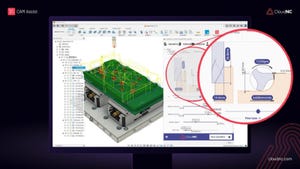Siemens HD-PLM Redefines Product Lifecycle Decision Making
June 3, 2010
At the heart of the latest release of the NX CAD system isnew HD-PLM technology, aframework Siemens PLM Softwaresays will transform the existing PLM paradigm into a high-definition,decision-support system that proactively guides users through the collaborativedesign process.
Borrowing key Web 2.0 and user interface principles andbuilt on modern technologies like role-based portals and Service OrientedArchitecture (SOA), HD-PLM delivers a more intuitive, personalized userexperience with PLM to aid in decision making throughout the entire productlifecycle, according to Eric Sterling, Siemens PLM Software's senior vicepresident of global marketing. Just-releasedNX 7 is the first product to leverage the HD-PLM framework, and subsequentversions of the Tecnomatix digital manufacturing software and Teamcenter PLMplatform will feature HD-PLM capabilities, including visual reporting andtagging.
Sterling says the vision for HD-PLM was driven by severalmacro industry trends, including influences like the popularity of Google andthe gaming industry's mark in establishing high expectations aroundpersonalization and visualization. Yet the biggest driver for HD-PLM iscustomers' need to get a better handle on the volumes of disparateproduct-related data and materials that they need to access and process inorder to aid in innovation efforts and bolster time to market. "There isdigital information overload within the engineering role, and our customers inPLM are getting that level of information and complexity in their day-to-dayjobs," Sterling explains. "The reason we named it high definition is this givesyou a whole new level of clarity in what you're seeing and how you see it."
HD-PLM, under development within Siemens for the last twoyears, employs four basic tenets to bolster decision making:
Personalization: Through the use of role-based technology and portals, HD-PLM will recognize a user in relation to their daily tasks and actively present them with information they need to perform their jobs. For example, an HD-PLM-enabled system would recognize a given user not just as a CAD operator, but as a powertrain engineer, and automatically personalize the workspace to put that individual in the proper context for the tasks they need to perform.
Assist: The software aggregates, delivers business analytics and monitors information, serving up data proactively to aid in collaborative decisions and notifying users when an action is required. In the vein of Web 2.0 platforms, the technology will suggest collaborators that can aid in decision making relative to the context of the problem at hand.
Clarify: The software employs now familiar interface paradigms like attaching tags to objects (popularized by Google Earth) or the "cover flow" GUI concept of iTunes to present "rich" information in an intuitive way to allow users to navigate to associated data from different disciplines and sources.
Validate: The HD-PLM technology allows users to validate decisions against best practices, while also employing analytics to assess design alternatives and let design teams capture their decision-making best practices for future reference.
In related news, Siemens unveiledNX 7, the latest upgrade to its 3-D CAD platform. The software's implementationof HD-PLM, specifically HD3D, lets the user visually explore PLM data withinteractive navigation as opposed to navigating and processing lists of attributedata and manually correlating them to 3-D product models. For instance, a usercan view a product's 3-D representation and easily get the right context toanswer questions related to project status, design changes, teamresponsibilities, suppliers, cost issues and other attributes. NX 7 employscolor coding, on-screen tagging and legends to enable fast visual analysis ofproduct development issues and decision criteria. HD3D also plays a role in NX7's validation checking tools, providing visually rich feedback, allowing usersto monitor critical functional requirements throughout development.
In addition to support for HD-PLM,NX 7 includes a variety of other enhancements, including new rapid design toolsto accelerate 2-D profile creation and positioning. The upgrade also integratesSynchronousTechnology with NX freeform modeling and delivers extensions to SynchronousTechnology in the areas of assemblies, thin-walled geometry, blends andchamfers. The new NX DraftingPlus tools further enhance 2-D functionality inNX, eliminating the need to use separate 2-D software.
NX 7 also ushers in a number ofCAE enhancements. The upgrade adds new integrated multi-physics solutions thatinclude durability and motion analysis with flexible bodies as well asadditional solutions for structural, thermal and flow analyses. There are alsotwo new CAE products--NX Finite Element (FE) Model Correlation and NX FE Model Updating,providing a complete, integrated system for modal analysis, pre-test planning,test-analysis correlation and model updating.
Siemens HD-PLM Redefines Product Lifecycle Decision Making A
You May Also Like

.jpg?width=300&auto=webp&quality=80&disable=upscale)

